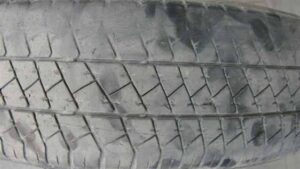
If you try to reach too high a speed quickly on an asphalt road, the vehicle may get stuck. Sometimes this is because the friction force of the tire depends on an important parameter called slip. As shown in the perfect rolling condition, the distance traveled by the wheel will be equal to the circumference of the wheel, the contact between the road and the tire will be on a line, in this case, in the case of pure rolling, the relative movement between the road and the tire is zero and obviously the slip is also zero, the opposite of this situation is the case of pure sliding or one hundred percent slip. In general tires behave between these two extremes, the contact area of the tire with the road will always be over an area due to the weight acting here, if you observe the wheel moving less than its circumference during a complete rotation, it is because the relative motion between the tire and the road is not exactly zero.

Does a Pure Tire Slide?
In the case of pure rolling and pure sliding, the tire and road molecules rub against each other and a friction force occurs in the opposite direction of the tire movement, in short, all contact part molecules will be sliding in this case. What will be the nature of this microscopic interaction during the 50 percent of sliding for example, such situations lead to the formation of another interesting region in the adhesion region called the adhesion zone, tire molecules and road surfaces form surface bonds called Van der Waals. Bonds and bond strength are weak You can find the same type of bonds between the graphite layers of a pencil cap, now you may be wondering how there can be a stable bond in a moving tire, the bonds in the adhesion zone are temporary These bonds must be broken as the tire moves, the force created by the road molecules on the tire molecules, sliding will be in the same direction as the friction force, there is still confusion among researchers regarding the location of adhesion and sliding zones. the total friction force produced by a tire will be the sum of the sticking and sliding friction values, in case of perfect rolling the sticking friction force value is always greater than the sliding friction force, the value of the friction force is zero but when the wheel is at one hundred percent the sliding friction comes into play, for other sliding levels the friction values are you can expect it to change like this but what happens in practice is completely different why such a strange behavior for friction change against sliding let’s take the classic example to understand this behavior a linear moving block the block does not move until the applied force overcomes the static friction force after the peak force the block slides friction The value drops suddenly. Let’s replace the x axis with the slip value instead of the applied force. This is also in the block example. Since a perfectly rolling tire has no relative motion with the road, it has zero slip or 100 percent slip. This is equivalent to a non-moving block. A 100 percent sliding tire is clearly a moving block. are the same, so it makes sense.

Solution to Prevent Tires From Slipping :
Due to the flexible properties of rubber, expect a similar graph for rolling tires, in which case the graph will be smoother. The slip-friction graph is very important in ABS technology and other vehicle dynamics analysis. The anti-lock braking system is designed to apply cuts in the range of 8 to 30 percent slip rate. we see how friction force and slip can be calculated experimentally we know the formula for calculating friction brake torque sensors are used to measure friction force normal force is measured using strain gauge using these two values friction coefficient is calculated slip rate is calculated using these equations both angular velocity and translational speed wheel speed it is measured using sensors translational speed is measured on wheels that are not broken but is applied to all four wheels when there are brakes a radar is used to estimate the translational speed of the vehicle, in this video we have studied the friction force change for straight line driving, when the vehicle makes a turn the contact area deforms the angle between the direction of rotation of the wheel The direction in which the sign and wheel move is known as the slip angle.
Leave a Reply